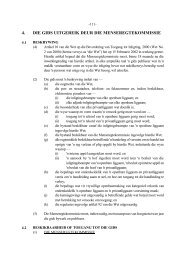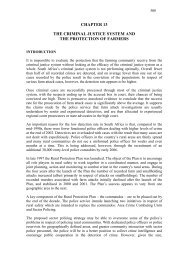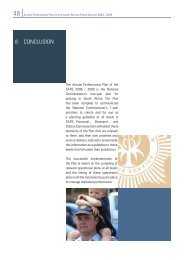Untitled - Saps
Untitled - Saps
Untitled - Saps
Create successful ePaper yourself
Turn your PDF publications into a flip-book with our unique Google optimized e-Paper software.
1995<br />
10 Years of Policing in a Democracy 1995 – 2005<br />
26<br />
• On 29 January 1995, President Nelson Mandela, appointed the first National<br />
Commissioner of the new South African Police Service, George Fivaz. He was assisted<br />
by four deputy commissioners, namely National Deputy Commissioners Morgan<br />
Chetty, Zolisa Lavisa, Mike Bester and John Manuel. In February 1995, the complete<br />
demilitarization of the police service was proposed. Other proposals included the<br />
abolition of military titles held by officers.<br />
• A ten-point community policing programme was launched in February 1995, the first of<br />
two stages of transforming the SAPS. The programme included the following:<br />
- Establishing station management forums to channel grievances.<br />
- Appointing shop stewards and complaints officers at district level.<br />
- Rotating schedules to prevent black police members from being assigned<br />
inferior jobs.<br />
- Redistributing resources between over-resourced and under-resourced stations.<br />
- Speeding up the incorporation of police assistants into the SAPS.<br />
- Improving the working environment of SAPS employees.<br />
- Implementing effective labour relations.<br />
• The SAPS Representivity and Equal Opportunities Programme (REOP), which formed<br />
the cornerstone of the SAPS transformation process, was launched at the end of<br />
May 1995.<br />
• A new rank structure for the SAPS was introduced on 1 December 1995. The new system<br />
heralded a visible and concrete break with the militaristic police culture of the past.<br />
• The new emblem of the SAPS was unveiled. Still based on a star design, the new emblem<br />
had as its centerpiece the aloe plant which symbolizes resilience and steadfastness.<br />
• New uniforms and insignia for the various ranks were phased in. The new uniform<br />
included a darker cap and a new name badge. Castle symbols denoting rank on epaulets<br />
were replaced by a hexagon showing the aloe plant.<br />
• Divisions that were established in addition to existing ones included the following:<br />
Division National Standards and Management Services: The division focused on providing<br />
management services in line with the constitutional and legislative functions of the SAPS,<br />
and determining and evaluating national standards in the delivery of policing services.<br />
The division consisted of three components, namely National Policy and Strategy,<br />
which formulated and implemented national operational policy and strategies; National<br />
Corporate Development, which interpreted and developed organizational policy<br />
into effective policing structures, management systems and procedures; and National<br />
Service Evaluation, which monitored and evaluated the services rendered by the SAPS<br />
in fulfilling its operational policies and strategies. The division followed a constructive,<br />
problem-solving approach, liaising internally with other SAPS divisions and externally<br />
with relevant communities and interested stakeholders. This approach assisted the SAPS<br />
in obtaining valuable input from crime-affected communities and in ensuring that the<br />
specific needs, fears and priorities of individual communities were addressed in the<br />
crime-combating activities of the SAPS. The Community Safety Plan was announced by<br />
former President Nelson Mandela in 1995, after being approved by all participants in the<br />
Government of National Unity.<br />
Division National Crime Investigation Services (NCIS): As every other division in the SAPS, the<br />
NCIS was also taking a new approach. In the past, the majority of the investigation units<br />
had followed a reactive approach to crime and solutions to crime. The division adopted a<br />
more preventive, proactive methodology and structure. In this way, crime was addressed<br />
by means of the effective utilization of information and the application of expert<br />
methods of investigation. Six components were assigned to the division, namely the<br />
Commercial Crime component, the National Priority Crimes component, the Organized

















